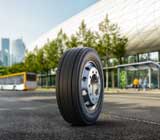Germany’s Continental is launching the new Conti Urban HA 5 NXT city bus tyre, with up to 60% of materials used renewable, recycled and ISCC Plus mass-balance-certified. By reducing rolling resistance by 25%, Continental enables electric buses to operate more efficiently and extend their range by up to 15%, it says.
Conti Urban HA 5 NXT is ideal for fleets looking for an efficient solution for urban traffic requirements, it adds. “In addition to the transformation to climate-friendly local public transport, this also includes familiar challenges such as curbs, frequent traffic lights, and driving in narrow streets,” says Hinnerk Kaiser, Head of Product Development Bus and Truck Tires EMEA at Continental.
The tyre manufacturer says it is consistently aligning its development for the bus segment with the megatrends of urbanisation and emission-free mobility. According to the EU authority Eurostat, around 80% of Europeans will live in urban centres by 2030. This makes low-noise and low-emission transport solutions and digital traffic management systems indispensable. The ambitious EU climate targets and new regulations are reinforcing this development.
According to the European Commission, only zero-emission buses will be newly registered from 2030. In 2024, 50% of all newly registered city buses in the EU were already clean. In countries such as the Netherlands, Denmark, Slovenia, Ireland, Finland, and Portugal, this figure was 100%.
In addition to the materials used, the tyre features rolling resistance-optimised tread that increases the range of battery-powered buses by up to 15%. It also reduces noise and meets EU label class A for external rolling noise. In addition, the Conti Urban HA 5 NXT is equipped with the latest generation of tyre sensors, enabling quick onboarding of a fleet into Continental’s digital tyre management system ContiConnect. The system provides fleet managers with insights into tyre pressure, temperature and mileage. This enables predictive maintenance, reduces downtime, and lowers operating costs, it says.

